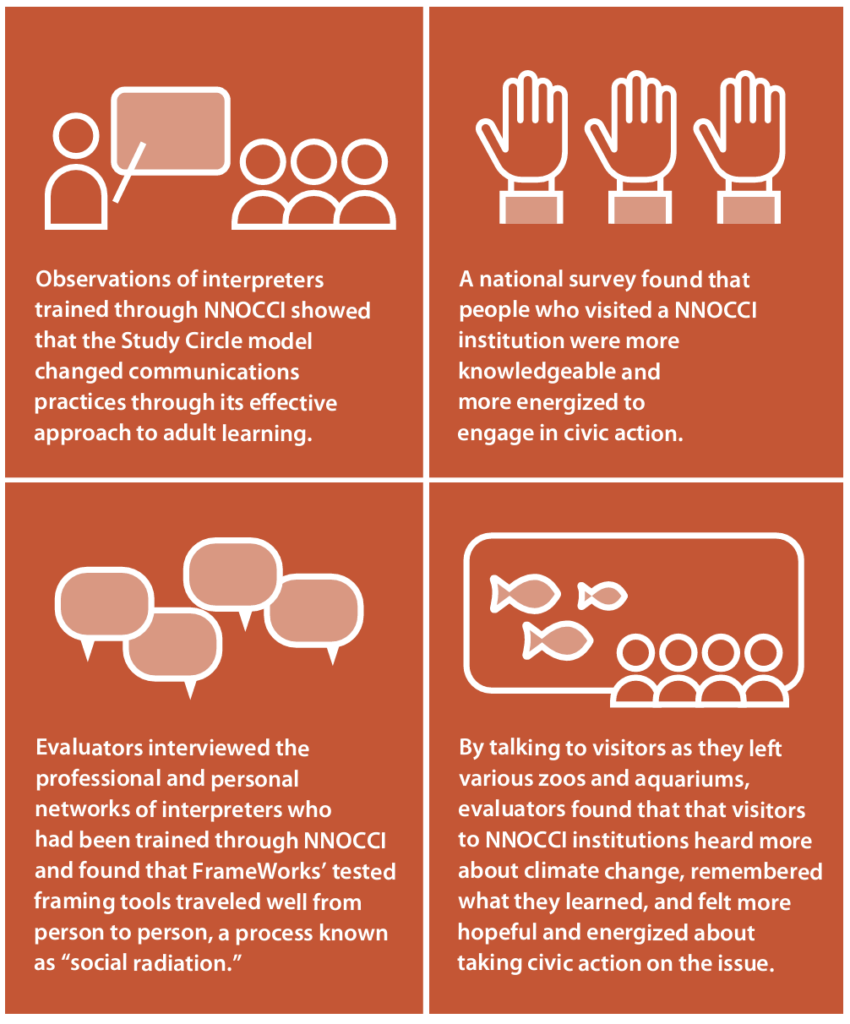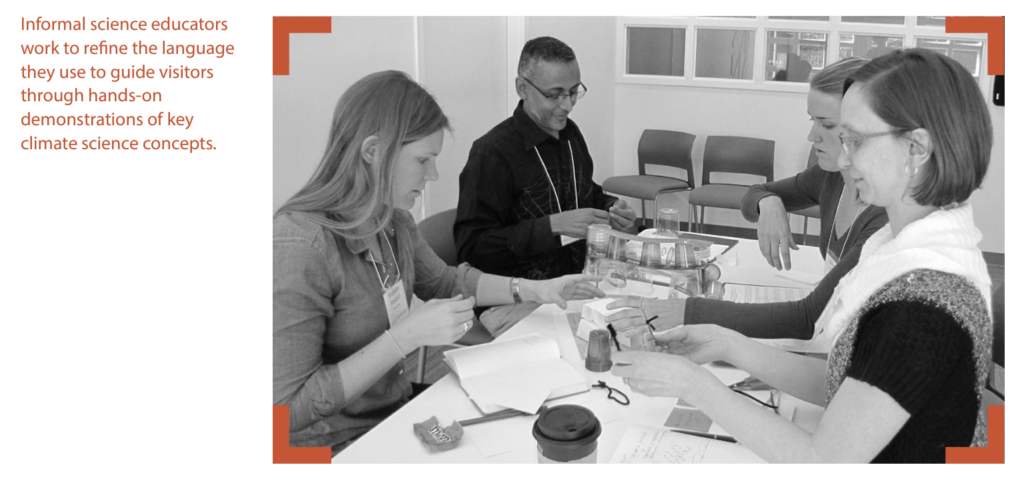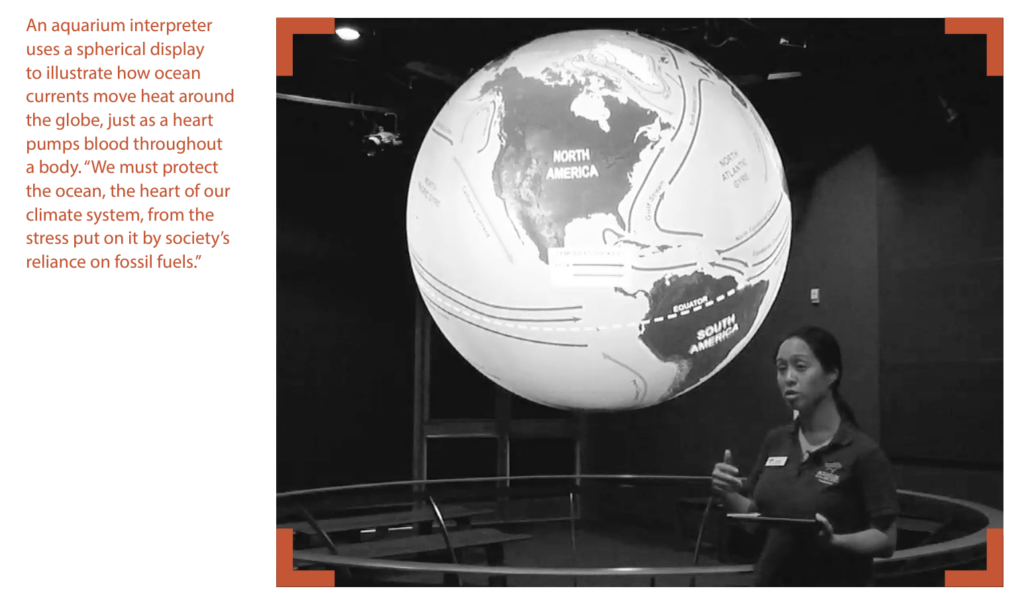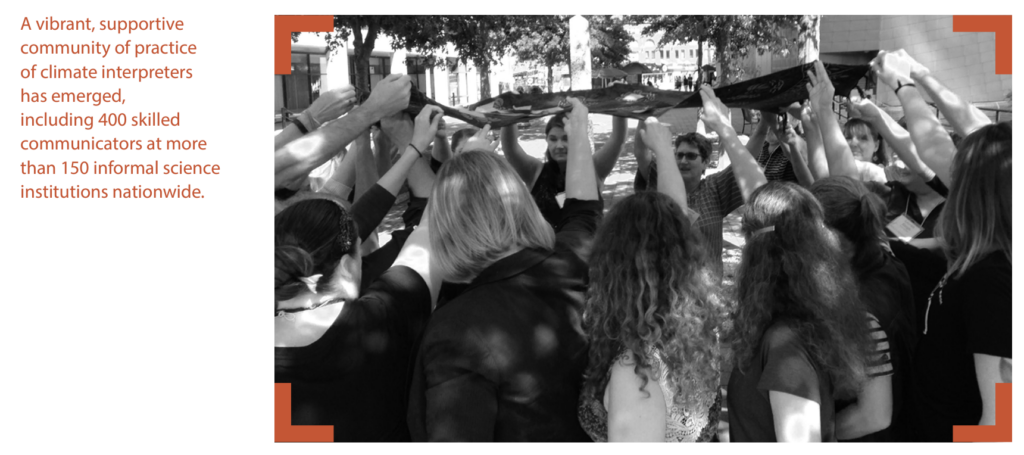Impact Story / Jul 2, 2019
Reframing Climate Change: Impact Brief
This evidence of effectiveness is what separates this climate communication initiative from others, according to Hannah Pickard, NNOCCI Network Manager at the New England Aquarium. “Because these recommendations were rigorously tested, and because we have an equally rigorous evaluation of their impact, we can build immediate confidence when we ask interpreters to start using them,” she said.
This impact brief tells the story of how those outcomes were achieved.
View as PDF

Strategic Framing Sparks Understanding, Hopefulness, and Action on Climate Change
In 2007, the leaders of the New England Aquarium— a team dedicated to the protection of the ocean—asked themselves a straightforward question during a strategic planning session: What are the most important issues facing the ocean?
The number one answer then, as now, was unequivocally climate change.
For a world-class institution committed to ocean conservation and education, it followed that climate change should be one of the issues they talked about most regularly with their 1.3 million visitors a year.
But it was not a topic of conversation at most of the nation’s aquariums at the time. And when the few daring informal science educators, known as interpreters, tried to broach it with visitors, they were often unsuccessful.
The whole issue seemed risky, complicated, overwhelming, politically divisive, and depressing—not exactly the kind of conversation an interpreter could easily and quickly navigate in a family-oriented setting people visited out of curiosity and a desire for some fun.
Today, there is a very different story to tell about the climate conversations taking place in aquariums, zoos, and other informal education centers across the US. More than 400 interpreters at 170 institutions in 38 states now center climate change in their interpretation. This community of practice reports training more than 38,000 additional messengers in the informal science world, and evaluators estimate that these communicators have spoken with nearly half of the American population. This major, large-scale shift in a sector’s communications practice has been linked to important changes in the national discourse on climate change—making it more productive, creative, and solutions-focused.
Through a major initiative called the National Network for Ocean and Climate Change Interpretation (NNOCCI), and with support from the National Science Foundation (NSF), informal science education centers are now at the forefront of evidence-driven education and citizen engagement on this important issue. The network is committed to Strategic Frame Analysis®, an evidence-based approach to communication developed by the FrameWorks Institute.
“Strategic framing on this issue makes the difference between a nice workshop on how to talk about climate change and a comprehensive approach designed to scale up.”
Nancy Hotchkiss, formerly of the National Aquarium in Baltimore.
Extensive external evaluations and research, conducted by Penn State University and NewKnowledge, supports Hotchkiss’s impression of the importance of FrameWorks’ approach to applied communications research. In short, this work has:
- Provided climate communications strategies that constructively engage people across the political spectrum;
- Mobilized a sector that attracts 195 million people a year—more than the number of people who attend all live major league sports events combined; and
- Proven that strategically translating the science of climate change leads to greater understanding, hopefulness, and action among interpreters and visitors alike.
This evidence of effectiveness is what separates this climate communication initiative from others, according to Hannah Pickard, NNOCCI Network Manager at the New England Aquarium. “Because these recommendations were rigorously tested, and because we have an equally rigorous evaluation of their impact, we can build immediate confidence when we ask interpreters to start using them,” she said.
This impact brief tells the story of how those outcomes were achieved.
Evidence of Impact
A rigorous, independent evaluation of NNOCCI, conducted by researchers at New Knowledge Organization and Pennsylvania State University over f ive years, validated FrameWorks’ approach in multiple ways.

The Power of a Committed Collective
Once the New England Aquarium—along with the National Aquarium and the Monterey Bay Aquarium—decided they wanted to focus on educating visitors about climate change, they looked for partners who could help them do it right.
They knew that scientific understanding and accuracy was key—so they engaged the world-renowned Woods Hole Oceanographic Institution to boost science educators’ knowledge of climate change. They also suspected that just three organizations in left-leaning states couldn’t change the narrative on their own. They engaged the Association of Zoos and Aquariums to help design an initiative that would have wide impact across the sector. Recognizing that it would be essential to know what worked, what didn’t, and why, they tapped NewKnowledge, an organization known for creative approaches to impact assessment, to serve as the evaluators.
For guidance on framing and communications, they partnered with the FrameWorks Institute, a pioneer in reframing social and scientific issues. FrameWorks’ researchers had studied the communications aspects of climate change, and its impacts on the ocean, since the Institute’s founding in 1999.
FrameWorks’ innovative analysis of widely shared patterns in public thinking had already led the field to adopt new ways of talking about some marine issues. For example, some environmental strategists argued that communications should tap into people’s association with the ocean as an important “resource” for humans. But FrameWorks found that consumerist thinking led people to respond to the issue of fishery depletion with an attitude that could be summed up as, “better eat ’em before they’re gone!” Instead of talking about the ocean in a utilitarian frame, FrameWorks found that it was more effective to explain how ecosystems worked, including people in the web of interconnection.
This partnership of informal science educators, climate scientists, and social scientists gained support first from the Institute of Museum and Library Services, and then was awarded funding from the National Science Foundation. From the start, the goal of NNOCCI was to mobilize a national effort to change the conversation about climate change and oceans—and do so in an evidence-based way that inspired hope and action.
The group was confident that blending the perspectives and strengths of communications science, climate science, and science education would be powerful. But many questions about how to make the most of the partnership remained open—not least how, exactly, should we frame conversations about how climate change is affecting the creatures that visitors come to see?
Solving the Communications Conundrum
Climate change, it is widely agreed, is one of the most challenging topics to communicate effectively. The data pointing to changes in climate are complicated, making it hard to get across to non-specialists. The issue is often mired in politics and polarization.
The impacts can feel overwhelming. And environmentalists have predominantly focused their communications efforts on building awareness of actions individuals can take in their own lives—little-picture solutions which policy experts agree are necessary but insufficient for the challenge at hand.
“One of the things you learn pretty quickly is that your instincts about how to communicate about this issue probably are not correct.”
Billy Spitzer, New England Aquarium.
To tackle emerging issues—like ocean acidification, or extreme weather— FrameWorks updated and expanded their climate communications research, using their latest methods to design and test communications strategies to guide the group. The process began with querying a panel of oceanographers and other experts to distill the major concepts that are essential to a sound understanding of the consequences of a changing climate.
This rigorous approach to ensuring scientific fidelity earned the stamp of approval from scientists like Sarah Cooley, Ph.D., Director of the Ocean Acidification Program at Ocean Conservancy, who participated in NNOCCI while a researcher at the Woods Hole Oceanographic Institute.
“I was just so happy to see that this approach legitimately embraces the science, and can work for scientists,” she said—adding that there is a growing appetite for this kind of accurate communications work among early career scientists.
With a set of scientific ideas to translate in hand, FrameWorks’ interdisciplinary team of linguists, anthropologists, political scientists, and sociologists developed multiple ideas for how to establish the issue’s importance, explain how it works, and ward off misperceptions—and then subjected each one to a series of tests to determine which ones were most effective in boosting public understanding.
“One of the things you learn pretty quickly is that your instincts about how to communicate about this issue probably are not correct,” said William (“Billy”) Spitzer, Ph.D., Vice President of Programs, Exhibits, and Planning at the New England Aquarium. “You really need to look at the data. In particular, you need to look at the communications strategies that cut through the clutter, that are understandable and memorable, and that people can transmit to others.”
Three of the most important recommendations found through the Strategic Frame Analysis are:
Recommendation #1: Begin conversations differently.
Many news stories and advocacy materials open up in ways that FrameWorks has found to have undesirable effects on public thinking: dire predictions of an uninhabitable planet, news peg-style reminders that the issue is a matter of partisan debate in the US, or a feel-good appeal that invites visitors to admire the cute critter in an exhibit. These framing tactics, respectively, spark fear, or “myside bias,” or a warm-and-fuzzy feeling—but do little to evoke a mindset conducive to scientific learning or civic change.
FrameWorks therefore recommends starting climate conversations with values—widely accepted ideals—to help convey that the communication is about education and civic dialogue. Through controlled survey experiments, FrameWorks’ researchers found that the two most effective values to invoke on this issue are protection and responsible management. Other values, such as scientific authority, did not demonstrate the ability to orient people toward climate change as an important public issue.
As zoo and aquarium interpreters adopted this reframing technique, they moved away from starting conversations by sharing fun facts about a creature in an exhibit, and began instead with statements like, “This sea star is delicate, and we have a shared responsibility to safeguard its habitat, and to protect it and the other creatures in its ecosystem.”
The shift toward shared values for messaging also helped to avoid framing climate change as a partisan issue, or even a controversial one. “FrameWorks recommendations on climate change take the issue out of the boxing ring and into the community,” said Julie Sweetland, Ph.D., Vice President for Strategy and Innovation at the FrameWorks Institute.
Recommendation #2: Focus on explanation, making climate mechanisms clear.
Climate change is a complex topic—and in a busy setting like a zoo or science center, it is important for communicators to have crisp, concise teaching tools at the ready.
Informal science educators have long known this. For instance, interpreters had quick, memorable ways to help people grasp the distinction between climate and weather. But FrameWorks’ research found that most non-specialists can already make that distinction. What they can’t do is make the connection between a changing climate and disruptions in long-standing weather patterns. Without an understanding of how climate affects weather, it is easy for people to observe heavy snowfalls or cold snaps and conclude that “global warming” isn’t “real.”
To boost public understanding of how the ocean, the climate, and the weather are all connected, FrameWorks researchers recommend explaining the ocean as the heart of the climate system—noting that just as a human heart circulates blood and regulates the body’s temperature, the oceans control the circulation of heat and moisture through the climate system. This metaphor has been found particularly useful by ocean scientists, such as Cooley.
Another example is to compare the build-up of atmospheric carbon dioxide to a “blanket effect.” This metaphor says:


When we burn fossil fuels for energy, we add more and more carbon dioxide into the atmosphere. This buildup acts like a blanket that traps heat around the world, which disrupts the climate.
“The heat-trapping blanket metaphor,” said Hotchkiss, “let us teach the basic mechanism of climate change in sixty seconds or less, which opened the door for the conversation, or gave us common ground for continuing it.”
Recommendation #3: Focus on collective, wide-scale solutions.
Given Americans’ cultural disposition toward self-reliance, it is not surprising that many climate communication efforts have focused on informing the public about actions they can take in their daily lives. But climate experts have concluded that individual efforts alone will not meet this challenge. Policy-level, systemic changes are also needed. And so, climate communicators also need effective ways to explain solutions that will work at the necessary scale.
From a framing perspective, it’s risky to take a “both-and” approach when talking about solutions. American individualism is so strong that once personal responsibility gets into a conversation, it crowds out thinking about collective solutions. For this reason, FrameWorks has found that it is most effective to concentrate communications efforts on inspiring people to join, or support, collective solutions.
The shift is subtle, but meaningful. Instead of encouraging a visitor to put solar panels on his or her roof, a NNOCCI interpreter would talk about community solar programs in which neighbors jointly support and subscribe to a localized renewable power source. This demonstrates feasible steps away from fossil fuels.

Or they describe sector-wide energy audits of public buildings and university campuses, illustrating energy efficiency on a scale that is intuitively more meaningful than switching lightbulbs at home.
While this change was initially uncomfortable for many climate interpreters, the research convinced many zoos, aquariums, and other informal science education organizations to embrace a collective action frame.
“We took on a new mindset from FrameWorks,” says Spitzer. “Their approach to social change views civic participation as essential; they see their communications work in that light. We took this seriously and said, OK, we’re going to train ourselves and our colleagues to talk, and think, differently about solutions.”
Mobilizing a Sector
Once FrameWorks’ researchers had solved the communications conundrum, FrameWorks’ instructional design team stepped in to help make sure the recommendations were used effectively and broadly.
FrameWorks’ instructional design team stepped in to help make sure the recommendations were used effectively and broadly.
FrameWorks’ expert trainers worked closely with experienced science educators to custom-build a framing curriculum tailored to the professional culture and concerns of zoo and aquarium interpreters. The resulting “Study Circle” design, adapted from an intensive learning model FrameWorks had used successfully for years, was a highly participatory experience, more akin to a learning community than a traditional course.
Several features of the NNOCCI Study Circles were built to meet the needs of these particular adult learners. To allow the time needed for professionals to both learn new communications techniques and build a strong professional network, the training involved a significant number of contact hours— about 75 hours, all told. Participants attended with a partner from their institution, building in a layer of readily-accessed peer support for applying new communications techniques in their work settings. Learning exercises were highly interactive and creative, yet relevant to the practical, everyday communications demands of their work settings. “We made sure that participants were practicing, but always in a meaningful way. We know how demanding their work can be. Framing had to become an integrated part of their work, not something extraneous,” according to Sweetland.
One essential strategy for engaging these professionals turned out to be the use of peer trainers, who could speak to the relevance and applicability of strategic framing to zoo and aquarium interpretation from a first-hand perspective. And so, NNOCCI and FrameWorks collaborated on a train-the-trainers model that equipped interpreters to lead Study Circles with only behindthe-scenes support from FrameWorks’ experts. The preparation, mentoring, and feedback loop for trainers was intensive, but in the end, this strategy allowed the initiative to achieve a scale that could have a noticeable impact across the sector. By the end of the grant period, about two out of every three institutions in the Association for Zoos and Aquariums had been reached, and the alumni network grew into the hundreds. The train-the-trainers model also built capacity within the network, so that the initiative was poised to sustain its momentum beyond the period of the grant award. And, in so doing, it showed that shared strategic framing—a common language—could be designed and deployed for broad reach and impact. In fact, program evaluators estimate that hundreds of thousands of visitors have already been reached by NNOCCI institutions.

Demonstrating Impact
Penn State University and NewKnowledge have conducted extensive research studies about this initiative’s impact—revealing that visitors to institutions where interpreters have been trained in strategic framing about climate change are more likely to be hopeful, confident, and solutions-focused than those who visit other centers or none at all.
“We absolutely could not have done this without strategic framing,” said Spitzer.
The external evaluators of the project agree. “Strategic framing was the essential catalyst that transformed this loose group of like-minded people into something more,” said John Fraser, Ph.D., and President and CEO of NewKnowledge. “What we saw, as psychologists, is that the idea of shared framing provided a clear purpose and path for creating the change they wanted.”
Once they had a technique to learn and apply together, they found a focus. In turn, that shared project allowed them to “develop into what is known as a ‘community of practice’—and that is the kind of community that has staying power,” he said.
In short, Fraser added, “it worked.”
“Strategic framing was the essential catalyst that transformed this loose group of like-minded people into something more.”
John Fraser, New Knowledge Organization.
In fact, the evidence—summarized in the graphic on page 4—yields a positive answer to most questions FrameWorks is asked about strategic framing in general, says Sweetland: “Can we teach it? Yes. Can other people teach and spread it through a train-the-trainers approach? Yes. Do the recommendations hold up outside the research setting, and have the effect with the public that the research predicted? Yes. Does reframing have an energizing, mobilizing impact across a network? Yes. Do the frames ripple out? Yes.”
Moving Forward
The NSF grant that initially supported this project came to an end 2018. But the work has continued. NNOCCI leaders are looking ahead to new ways to sustain and expand the existing network and deepen the impact of the work over time. In fact, these once-reticent climate communicators are now so confident in engaging the public that their most recent project involves going beyond the walls of their education center to partner with community-based organizations in neighborhoods that are vulnerable to the impacts of climate change. “NSF funding was the engine that got this going. But the tools and how people are using them have become part of fabric of their work and who they are,” said Hotchkiss.
In the end, Fraser observes, one critical ingredient of this initiative’s success is that it gives interpreters across the informal science education sector something concrete and demonstrably effective to do about climate change. And on a subject so typically associated with doom and gloom that, in itself, points to a light at the end of the tunnel.
Learn More
More details on the evidence of impact is available in these peer-reviewed studies:
Geiger, N., Swim, J. K. and Fraser, J., 2017. Creating a climate for change: Interventions, efficacy and public discussion about climate change. Journal of Environmental Psychology, 51, 104–116.
Geiger, N., Swim, J. K., Fraser, J., and Flinner, K., 2017. Catalyzing public engagement with climate change through Informal Science Learning Centers. Science Communication, 39(2), 221–249.
Swim, J. K., and Fraser, J., 2013. Fostering hope in climate change educators. Journal of Museum Education, 28(3), 286–297.
Swim, J. K., and Fraser, J., 2014. Zoo and aquarium professionals’ concerns and confidence about climate change education. Journal of Geoscience Education, 62(3), 495–501.
Swim, J. K., Fraser, J., and Geiger, N., 2014. Teaching the choir to sing: Use of social science information to promote public discourse on climate change. Journal of Land Use and Environmental Law, 30(1), 91–111.
Swim, J. K., Geiger, N., Fraser, J., and Pletcher N., 2017. Climate change education at nature based museums. Curator: The Museum Journal, 60(1), 101–119.
Issues: Climate Change and Environment
Countries: United States